Diamonds used in RAMPANT LION COLLECTIONS® Classic Collection are VS clarity, F-G color, and fine make. All of our diamonds are conflict free and have been acquired from companies trading under the UN-mandated Kimberly Process.
Azurite / Malachite
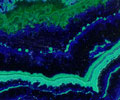
The copper mines of Arizona produce a fascinating mineral known as Azurite/Malachite. Malachite, with its whirling patterns of iridescent greens, combined with the deep azure blues of Azurite, creates an exotic mineral combination that is a favorite for collectors throughout the world.
Bloodstone
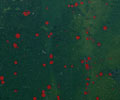
A mineral from the medieval world, bloodstone traces its popularity to the time of the Christian Crusades. A forest green chalcedony with specks of red jasper, bloodstone is sacred to Christians as the stone signifies the blood of a crucified Jesus Christ on a field of green. Our bloodstone in mined in India and is also known as a birthstone for March.
Boulder Matrix Opal
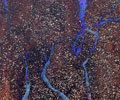
The world's finest opals are found in Australia. In the Australian state of Queensland, miners find nodules of brown iron oxide with veins of precious blue, green, and red opal. More commonly known as boulder matrix opal, this handsome material excites the senses. Opal is also known as a birthstone for October.
Chrysoprase
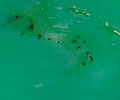
Apple green chrysoprase is the rarest and most valuable of all chalcedonies. Long revered for its opalescent green color, chrysoprase traces its jewelry roots back to the Egyptians, Greeks and Romans. Metaphysically, chrysoprase imparts a sense of grace, heals broken hearts, increases fertility, and balances yin-yang energy. Our material originates in Tanzania and Australia.
Copper Quartz
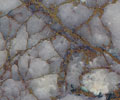
From the copper mines of Arizona comes a most uncommon quartz mineral with veins of copper, cuprite, chalcocite, and silver. This rare material reflects the earthen moods of the Southwest.
Crystalline Silver
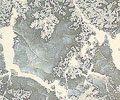
Like a lightning storm surging through a stormy winter's sky, our Crystalline Silver displays veins and dendrites of native silver coursing through a gray-black marble base. Originating in the abandoned silver mines of North America, our Crystalline Silver is a rare metallic mineral selected from a collection that was mined nearly 100 years ago.
Donosaur Bone - Fossilized
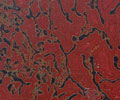
From the dawn of prehistory, thunderous beasts roamed the earth. Their fossilized remains are all that we now have to remember them by. Aged red-brown in the high deserts of North America, our dinosaur bone is esily recognizable by its tight cellular structure. All our fossilized dinosaur bone has been legally extracted prior to current antiquities regulations.
Gaspeite
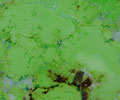
From the depths of the Australian outback, an area known for its rare and unique gemstones, comes a "sherbet lime green" gem material, breathtaking in its intensity of color, called gaspeite, a trade name for green nickeliferous magnesite.
Gold Quartz
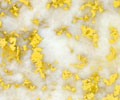
Deep in the mother lode of California gold country, high grade ore mines produce spectacular specimens of white quartz with natural veins of gold. This American "Gold Quartz" is eagerly sought after by museums, collectors, and jewelers all over the world. Each piece of "Gold Quartz" has its own unique pattern.
Jadeite - Green Galactic

For over three thousand years, the Olmecs, Mayas, and Aztecs carved and worshipped jadeite as the physical embodiment of immortality. Long known by the ancients as the toughest and most durable of materials and considered more valuable than gold, jadeite came to be associated with even those elements defining life itself. In an extremely rare occurrence unique to the world, a green/black jadeite, known as Galactic Gold, with visible traces of gold, silver, copper, platinum, cadmium, nickel, zinc, and other heavy metals has been discovered in Central America.
Jadeite - Lavender
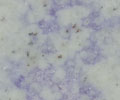
For over three thousand years, the Olmecs, Mayas, and Aztecs carved and worshipped jadeite as the physical embodiment of immortality. Long known by the ancients as the toughest and most durable of materials, jadeite came to be associated with even those elements defining life itself. More valuable than gold, this Meso-American jadeite comes in many colors, with lavender being a favorite.
Lapis Lazuli
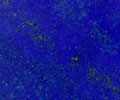
High in the Hindu Kush mountains of Afghanistan, along Marco Polo's silk route to China, native miners search for a royal blue mineral with flecks of gold pyrite known as lapis lazuli. Since the times of the ancient pharaohs of Egypt, lapis lazuli has been used for purposes of both ornamentation and adornment. Lapis lazuli is also known as an alternate birthstone for December.
Mammoth Ivory - Fossilized
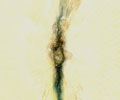
Far to the north, in the land of the Arctic wind, lived gargantuan woolly mammoths. They may have perished thousands of years ago, but they left behind their huge ivory tusks as legacies, fossilized and preserved in the arctic permafrost. All our fossilized mammoth ivory has been legally extracted from private Alaskan lands. We use only the whitest ivory with natural patterning that comes from the core of the tusk.
Mayan Skystone™
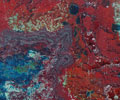
Swirls of blood-red cuprite, azure-blue chrysocolla, and cerulean shattuckite ignite in a profusion of breathtaking colors remarkable even in the gem world. Recently discovered in Mexico, our Mayan Skystone™, in capturing the tropical spirit of the land, sea, and sky, mirrors the character of the Yucatan.
Nephrite Jade - Black

Because of its fibrous nature, jade is known as one of the toughest, most durable, and most legendary of all gemstones. Popularized in ancient China, jade often took the place of gold and gems as a repository of value. Our lustrous black jade is mined in the western United States.
Nephrite Jade - Green Polar

As the brightest and hardest of all nephrite jades ever found, polar jade is known for its swirling shades of brilliant green. Not only is jade the toughest stone known to man, it is probably the most worshipped stone in human history, having been revered by the Russians, Chinese, and Indians of the Pacific Northwest, Meso-America, and New Zealand. This new discovery from British Columbia, Canada, even rivals green jadeite in intensity of color and translucency.
Nephrite Jade - Honey or White Siberian
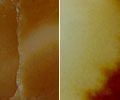
From Russia, in central Siberia near the great lake Baikal, are found many colors of nephrite jade, one of the toughest and most durable gem materials known. Long a favorite of the Russian royal families and Chinese emperors, nephrite jade has been fashioned into everything utilitarian from ax heads to sarcophagi. Of special significance is its use in personal ornamentation where nephrite jade often took the place of gold and gems as a repository of value. Notable Siberian colors are sea green, white and honey.
Orange Chalcedony

Orange chalcendony, more commonly known as carnelian, takes its name from the Latin cornum (cornel berry), the color of which it closely resembles. India provides us with the best qualities. Colors range from light red to orange with some stones a deep red. Cornelian was thought to quiet the blood and soften anger.
Rhodochrosite
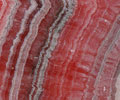
In the ancient Inca silver mines of the thirteenth century, a very rare occurrence of stalactites and stalagmites formed from concentric red/pink/white banding of a magnesium carbonate mineral more commonly known as rhodochrosite. Also called Inca Rose, this unique Argentine material is believed to balance ones mental processes, harmonize internal and external conflicts and expand ones consciousness.
Ruby in Zoisite
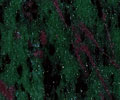
From Tanzania in gem rich central Africa, a translucent green zoisite is found interspersed with black hornblend inclusions and magnificent red ruby crystals. This exotic gem material is known as anyolite, or locally as Masai Green.
Sugilite
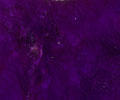
From the fields of South Africa, a magenta hued gem known as sugilite has been found in association with manganese. Metaphysically, this opaque reddish purple stone provides a protective energy against negativity and empowers one with nurturing vibrations that enhance ones spirituality.
Tiger Iron
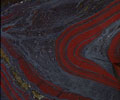
Mined from an Archean formation three billion years old, tiger iron, made up of swirling bands of metallic iron ore, red/brown jasper, and iridescent golden tigereye, mirrors the earthen colors of the great Australian outback.
Turquoise - American Blue or Chinese Blue or Green Spiderweb
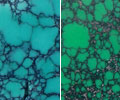
From the dynasties of ancient Egypt to the Indian tribes of the American Southwest, turquoise has achieved a mythical importance as a decorative mineral imbued with the supernatural power of the sky and the sea. Our turquoise is found in the arid Hubei Province of China and the deserts of Arizona where miners search for blue and green turquoise with an intricately patterned spiderweb matrix. Turquoise is also known as a birthstone for December.
For Opaque Inlay Materials
Most Durable
Black Nephrite Jade
Bloodstone
Chrysoprase
Green Galactic Jadeite
Green Polar Nephrite Jade
Honey Siberian Nephrite Jade
Lavender Jadeite
Ocean Jasper
Orange Chalcedony
White Siberian Nephrite Jade
Average Durability
American Blue Spiderweb Turquoise
Chinese Blue Spiderweb Turquoise
Chinese Green Spiderweb Turquoise
Crystalline Silver
Fossilized Dinosaur Bone
Fossilized Mammoth Ivory
Gaspeite
Gold Quartz
Lapis Lazuli
Mayan Skystone™
Ruby in Zoisite
Sugilite
Special Care
Azurite/Malachite
Boulder Matrix Opal
Copper Quartz
Rhodochrosite
The gemstone materials inlaid in RAMPANT LION COLLECTIONS® jewelry are selected primarily for their unsurpassed beauty with a secondary emphasis placed upon gemstone hardness.
Treatment: Where appropriate, our rough gemstone materials are enhanced by vacuum treatment with chemical stabilizers and hardening agents. This treatment improves the material's stability and, hence, durability and wearability. Since our materials are largely ornamental (intrinsically of a lesser gemological value), these treatment processes enhance, rather than diminish, the value of our gemstones.
Care: The wearer should be cautious and avoid situations that might damage our inlaid gemstones or the epoxies used in the inlay process. Excessive heat from ring sizing and ultrasonic and steam cleaning, strong soaps, oils, chemicals and instances where our jewelry might strike another surface and cause the gemstone to chip or crack should be avoided. Likewise, these damaging elements can undermine the epoxy used to cement the inlay stone and result in gemstone loss. It is prudent to always handle our jewelry with care.
